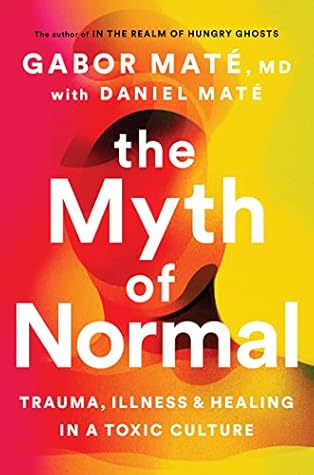More on this book
Community
Kindle Notes & Highlights
by
Gabor Maté
Started reading
July 8, 2025
Another way of saying it: chronic illness—mental or physical—is to a large extent a function or feature of the way things are and not a glitch; a consequence of how we live, not a mysterious aberration.
despondence and hopelessness “are chronic stressors which will have significant, long-lasting and incremental negative implications on the mental health of children and young people.”[14]
In medical practice, the word “normal” denotes, among other things, the state of affairs we doctors aim for, setting the boundaries delineating health from disease. “Normal levels” and “normal functioning” are our goal when we apply treatments or remedies. We also gauge success or failure against “statistical norms”; we reassure worried patients that this symptom or that side effect is completely normal, as in “to be expected.” These are all specific and legitimate uses of the word, enabling us to assess situations realistically so that we can aim our efforts appropriately.
pass. For better or worse, we humans have a genius for getting used to things, especially when the changes are incremental. The newfangled verb “to normalize” refers to the mechanism by which something previously aberrant becomes normal enough that it passes beneath our radar. On a societal level, then, “normal” often means “nothing to see here”: all systems are functioning as they should, no further inquiry needed.
those features of daily life that appear to us now as normal are the ones crying out the loudest for our scrutiny.
I will make the case that much of what passes for normal in our society is neither healthy nor natural, and that to meet modern society’s criteria for normality is, in many ways, to conform to requirements that are profoundly abnormal in regard to our Nature-given needs—which is to say, unhealthy and harmful on the physiological, mental, and even spiritual levels.
health and illness are not random states in a particular body or body part. They are, in fact, an expression of an entire life lived, one that cannot, in turn, be understood in isolation: it is influenced by—or better yet, it arises from—a web of circumstances, relationships, events, and experiences.
Healing is not guaranteed, but it is available. It is no exaggeration to say at this point in Earth’s history that it is also required.
The meaning of the word “trauma,” in its Greek origin, is “wound.” Whether we realize it or not, it is our woundedness, or how we cope with it, that dictates much of our behavior, shapes our social habits, and informs our ways of thinking about the world.
In the present century, the leading trauma psychologist and healer Peter Levine has written that certain shocks to the organism “can alter a person’s biological, psychological, and social equilibrium to such a degree that the memory of one particular event comes to taint, and dominate, all other experiences, spoiling an appreciation of the present moment.”[2] Levine calls this “the tyranny of the past.”
someone without the marks of trauma would be an outlier in our society.
intimate, with them? A more basic question comes first: What is trauma? As I use the word, “trauma” is an inner injury, a lasting rupture or split within the self due to difficult or hurtful events. By this definition, trauma is primarily what happens within someone as a result of the difficult or hurtful events
“Trauma is not what happens to you but what happens inside you”
trauma is an antecedent and a contributor to illness of all kinds throughout the lifespan.
“Trauma is perhaps the most avoided, ignored, belittled, denied, misunderstood, and untreated cause of human suffering.”[6]
It underlies much of what gets labeled as mental illness. It also creates a predisposition to physical illness by driving inflammation, elevating physiological stress, and impairing the healthy functioning of genes, among many other mechanisms. To sum up, then, capital-T trauma occurs when things happen to vulnerable people that should not have happened,
If, despite decades of evidence, “big-T trauma” has barely registered on the medical radar screen, small-t trauma does not even cause a blip.
Even as we make this distinction between big-T and small-t traumas, given the continuum and broad spectrum of human experience, let’s keep in mind that in real life the lines are fluid, are not easily drawn, and should not be rigidly maintained.
comparisons fail. It doesn’t matter whether we can point to other people who seem more traumatized than we are, for there is no comparing suffering.
Not knowing how or what one feels, on the other hand, is a sure sign of disconnect from the body.
the freeze response that creatures often display when fight and flight are both impossible.
Among the most poisonous consequences of shame is the loss of compassion for oneself.
The most common form shame assumes in this culture is the belief that “I am not enough.”
people were desperately seeking an escape from themselves. If trauma entails a disconnection from the self, then it makes sense to say that we are being collectively flooded with influences that both exploit and reinforce trauma. Work pressures, multitasking, social media, news updates, multiplicities of entertainment sources—these all induce us to become lost in thoughts, frantic activities, gadgets, meaningless conversations. We are caught up in pursuits of all kinds that draw us on not because they are necessary or inspiring or uplifting, or because they enrich or add meaning to our lives,
...more
Ultimately, what we are distracted from is living.
most people still know—if only on a gut level—that what they think and how they feel have everything to do with each other.
what unprocessed fears lead one to experience panic attacks.
As Dr. Epel told me, the effects of our socioeconomic environment are visible within our cells, if one knows what to look for.


